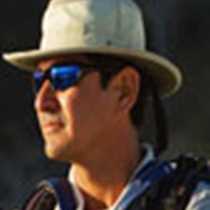North Seymour and Rabida Islands
Happy New Year to you, my dear reader! I wish you were here, having fun in the Galápagos, just like we are with our guests onboard the National Geographic Endeavour.
Early in the morning we had our nutritious breakfast and soon after a dry landing at North Seymour, searching for wildlife. North Seymour is a small island located in the center of the archipelago, surrounded with underwater seamounts, a safeguard for schools of fish and consequently close to many “fish-markets,” which makes it a preferred island for seabirds of different kinds, like frigatebirds, blue-footed boobies and swallow-tailed gulls.
There are also reptiles like lava lizards, marine and land iguanas; and, of course, our favorite marine mammal and ever-present friend, the Galápagos sea lions. They know this is the right place to start a family, because you can safely leave your progenies for a few hours, search for fish and then get back to them with some food for their nourishment; making them stronger and fit, insuring their offspring’s future survival.
We came back on board and started for our next destination while many activities took place: our safety snorkeling briefing in the lounge followed by equipment fittings on the sun deck, then lunch astern by the pool or in the dining room. Afterward, Expedition Leader Cindy Manning gave a talk about Galápagos.
We arrived to Rabida Island and anchored close to the beach while our crew deployed kayaks, Zodiacs, and a glass-bottom boat. We all started exploring the oceans; today our snorkelers were very lucky as we saw all that this site has to offer – penguins, sea lions, white-tipped sharks, rays, turtles, sea stars, lobster, marine iguanas feeding, massive schools of fish and hunters like groupers – all within an hour. A rush of excitement filled our bodies with happiness, for today we visited the Galápagos underwater realm, a unique marine reserve.
When I came back on board I thought how unusual our snorkeling was, and now I can honestly guess “La Nina” is here, since this is not the typical biological setting; the ecosystem has shifted, giving way to those fit to survive. I have not perceived a variation so intense for at least a decade. Keep your eyes open and your senses sharp, my dear reader, all gyros are interconnected in this world of ours and I’m sure these dramatic fluctuations will change your surroundings. Enjoy Mother Nature’s occasional shifting, enjoy this new year of 2012.
Back to the ship for a quick shower and back to the island again, but this time for a wet-landing on this impressive red iron-oxide sandy beach. Once we set a foot on Rabida we were immediately greeted by baby sea lions, making our young explorers very excited to say the least. In this picture you see our guest filming them while smiling, for this is a wonderful way to start the new year, with her family in the Galápagos.
After our walk we gathered on board for our briefing about the next day’s activity, dinner and a hands-on photography session.
It’s late at night, my turn writing our first daily expedition report of the year. My dear reader, I wonder where you are and what your world is like. I hope I gave you an idea of ours, this far, this isolated, this majestic. I know I’ll see you sometime and you will understand this place that is so special and has no way to be described; our guests and previous visitors now know so. Wishing you were here, wishing you a wonderful New Year.




